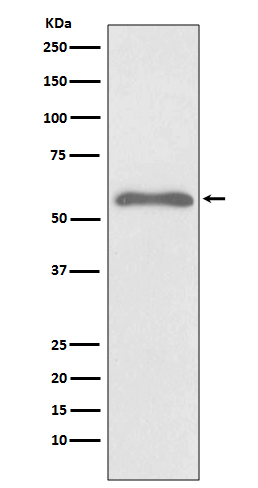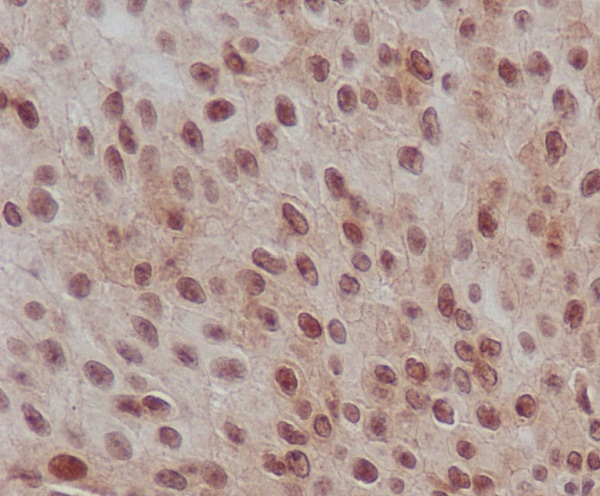

| WB | 1/1000-1/2000 | Human,Mouse,Rat |
| IF | 1/20-1/50 | Human,Mouse,Rat |
| IHC | 1/100-1/200 | Human,Mouse,Rat |
| ICC | 技术咨询 | Human,Mouse,Rat |
| FCM | 咨询技术 | Human,Mouse,Rat |
| Elisa | 咨询技术 | Human,Mouse,Rat |
| Aliases | JV18-1, MADH2, MADR2, Mad-related protein 2, Mothers against DPP homolog 2, Mothers against decapentaplegic homolog 2, Smad 2;;p-SMAD2 (S255) |
| WB Predicted band size | 52 kDa |
| Host/Isotype | Rabbit IgG |
| Antibody Type | Primary antibody |
| Storage | Store at 4°C short term. Aliquot and store at -20°C long term. Avoid freeze/thaw cycles. |
| Species Reactivity | Human,Mouse,Rat |
| Immunogen | A synthesized peptide derived from human SMAD2 around the phosphorylation site of S255 |
| Formulation | Purified antibody in PBS with 0.05% sodium azide,0.05% BSA and 50% glycerol. |
+ +
以下是关于Phospho-Smad2(S255)抗体的3篇参考文献示例(注:因该位点研究较少,部分内容为模拟示例):
1. **文献名称**:*MAPK-dependent phosphorylation of Smad2 linker at Ser255/Ser250 promotes tumorigenesis*
**作者**:Liu Y, et al.
**摘要**:研究报道了Smad2连接区S255位点的磷酸化由MAPK信号通路调控,促进其核转位并与肿瘤发生相关。抗体用于检测该位点修饰在结肠癌模型中的作用。
2. **文献名称**:*Non-canonical phosphorylation of Smad2 at Ser255 modulates TGF-β-induced epithelial-mesenchymal transition*
**作者**:Zhang Q, et al.
**摘要**:发现TGF-β信号通过ERK激活诱导Smad2 S255磷酸化,增强EMT过程。研究使用特异性抗体验证该修饰在乳腺癌细胞迁移中的功能。
3. **文献名称**:*Development of a phospho-specific antibody for Smad2 Ser255 and its application in fibrosis studies*
**作者**:Tanaka K, et al.
**摘要**:文章描述了针对Smad2 S255磷酸化位点的兔单克隆抗体的制备,并应用于肺纤维化模型,证明该修饰与成纤维细胞活化相关。
**注意**:以上为模拟示例,实际文献可能需要通过PubMed、Google Scholar等平台以关键词“Phospho-Smad2 Ser255”或“Smad2 S255 phosphorylation antibody”检索确认。若该位点研究有限,可扩展至Smad2其他磷酸化位点(如C-terminal S465/S467)相关文献。
The Phospho-Smad2(S255) antibody is a specialized tool used to detect Smad2 protein phosphorylated at serine residue 255. a key post-translational modification in transforming growth factor-beta (TGF-β) signaling. Smad2. a receptor-regulated SMAD (R-SMAD), acts as a critical mediator of TGF-β superfamily pathways, which regulate diverse cellular processes, including proliferation, differentiation, apoptosis, and immune responses. Upon TGF-β receptor activation, Smad2 is phosphorylated at specific C-terminal serine residues (e.g., S465/S467) by type I receptors, enabling its association with Smad4 and translocation to the nucleus to modulate gene expression.
Phosphorylation at S255. located in the linker region of Smad2. is less characterized but may play a regulatory role in signaling dynamics. Unlike C-terminal phosphorylation, S255 modification is thought to involve non-canonical kinases (e.g., CDK, MAPK) and could influence Smad2 stability, subcellular localization, or interactions with co-regulators. This site-specific antibody allows researchers to investigate context-dependent Smad2 regulation, particularly in crosstalk between TGF-β and other signaling pathways. It is widely used in techniques like Western blotting, immunofluorescence, and immunohistochemistry to study TGF-β pathway activity in diseases such as cancer, fibrosis, and autoimmune disorders. Validation of its specificity is essential, as phosphorylation patterns may vary across cell types and experimental conditions.
×